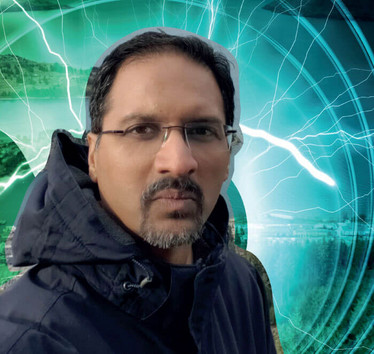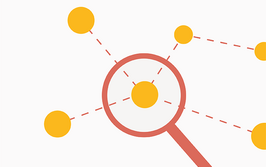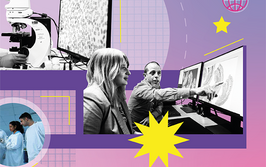When the Current Serves
Sitting Down With… Anant Madabhushi, F. Alex Nason Professor II of Biomedical Engineering and Director of the Center for Computational Imaging and Personalized Diagnostics at Case Western Reserve University, Cleveland, USA
Luke Turner | | Interview

Why did you pursue digital and computational pathology?
My initial plan was to study medicine, but my application was unsuccessful. Biomedical science seemed like the next best thing and it was a subject I could get excited about, so I began my degree in biomedical engineering in Bombay, India. During my studies, I was exposed to medical imaging and realized that the integration of computer science and imaging was a sweet spot for me. I began to develop pattern recognition algorithms, not to find cancer, but to find people in videos and to recognize certain movements.
During my PhD, I really started to zero in on the computational analysis of medical images, starting with radiography. I was fortunate enough to meet two pathologists: Mike Feldman and John Tomaszewski. One day, Mike said to me, “Imagine if you could digitize this little slide and start to interrogate it computationally; think about the opportunities.” I picked it up and replied, “This little thing? That should be trivial!” I didn’t realize that one small slide would produce gigabytes of data! That was just the beginning – shortly thereafter, we published the first paper on digital pathology.
How close are we to using algorithms in routine clinical practice?
In the US, my sense is that many artificial intelligence (AI) and machine learning algorithms will now receive 510(k) designation from the FDA, rather than the traditional premarket approval. And that’s a big deal; we’ll see many more submissions and much faster turnaround times, leading to new algorithms’ being approved within two to three months. However, despite getting approval from the FDA, we must achieve certain inflection points to see wide-scale deployment.
Fundamentally, it’s about monetization. If hospitals and medical institutions buy and deploy this kind of technology, they need to know where the return on their investment will come from. For that to happen, AI technology needs its own Current Procedural Terminology (CPT) codes for billing. Once the technology justifies its own CPT codes, I believe we’ll see a significant inflection point.
What are you most excited about when it comes to computational pathology?
The proteomics, genomics, metabolomics, and transcriptomics of a tumor are fundamentally reflected in traditional H&E slides. I am extremely excited by this because it’s the lowest common denominator; you can take breast cancer tissue from patients in Liberia, Birmingham, Sydney, and Cleveland, and they will all produce the same slide stained with the same two things – hematoxylin and eosin. We can now digitize those slides, upload the images to the cloud, and analyze them from anywhere in the world. That global impact will be a great leveler for low- and middle-income countries that can’t afford expensive molecular diagnostic tests.
How do you balance your leadership positions, research areas, and personal interests?
“There is a tide in the affairs of men. Which taken at the flood, leads on to fortune; omitted, all the voyage of their life is bound in shallows and in miseries. On such a full sea are we now afloat, and we must take the current when it serves, or lose our ventures.” This quote from Shakespeare’s play Julius Caesar reflects my career journey so far. I didn’t deliberately seek out all of the fields I currently work in, but when opportunities presented themselves, I started moving into different disease areas and “took the current when it served.”
It also demonstrates my love for theater and literature; I even have a Diploma in Speech and Drama from Trinity College London. I indulge my interest in literature through my eight-year-old son, who can quote the entire opening monologue from Henry V! Although there’s no magic recipe to maintaining a healthy work-life balance – and, sometimes, something has to give – I exercise every week to ensure I don’t go insane!
I pursue so many different avenues to continue to build visibility and excitement in this space. Back in 2007, when a few of us started the first digital pathology meeting, we held it in a classroom because only 14 people attended. It’s fantastic that, in just 12 years, we’ve gone from a very small niche to having several large annual meetings. But we haven’t forgotten the pain that came with early failures. It has made us resilient; I think we recognize that we must continue to champion the idea to sustain and grow interest.
What are the proudest moments of your career so far?
I am most proud of things that relate to the visibility of the field as a whole, rather than to personal recognition. For example, in 2017, I was honored with the Institute of Electrical and Electronics Engineers (IEEE) Engineering in Medicine and Biology Society (EMBS) Technical Achievement Award. This was the first time it was awarded for contributions to digital pathology, so I felt as though I was carrying the flag for the whole community.
For me, the real accomplishment will be when these technologies are actually used to modulate treatments for patients – that’s the ultimate goal. My present focus is on increasing the visibility of digital and computational pathology, laying the platform to transition these technologies to the clinic on a large scale.
While completing my undergraduate degree in Biology, I soon discovered that my passion and strength was for writing about science rather than working in the lab. My master’s degree in Science Communication allowed me to develop my science writing skills and I was lucky enough to come to Texere Publishing straight from University. Here I am given the opportunity to write about cutting edge research and engage with leading scientists, while also being part of a fantastic team!




















